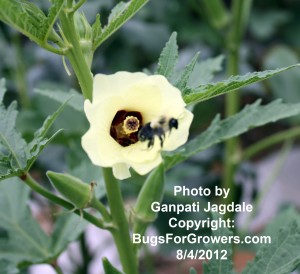Bumblebees, Bombus impatiens are currently used for pollination of various crops- BugsForGrowers.com
Over 75% globally grown and economically important crops rely either in part or completely on animal pollination. Both honeybees (Fig. 1) and bumblebees have been employed for pollination of many crops. Both the outdoor and greenhouse grown plants including cucumbers, peppers, squash, tomatoes etc. require the additional assistance for pollination for setting of fruits. For outdoor grown plants, a job of pollination is done naturally by wind, honeybees, bumblebees and wasps but the pollination of plants that grown in the greenhouses require an employment of human labor or release of bumblebees.

Currently, three species of bumblebees (Fig. 2.) including Bombus spp., B. impatiens, and B. occidentalis have been used for the pollination of following different crops. When compared with honeybees, bumblebees are bigger in size and faster and therefore, most of the organic growers have success with bumblebee hives with the huge labor-savings and improved fruit-sets.

List of vegetable crops, fruits and nuts can be pollinated by various species of bumblebees.
Field and greenhouse vegetable crops:
- Broad bean, Vicia faba
- Cantaloupe and Melon, Cucumis melo
- Bell, green and red peppers, Capsicum annuum, Capsicum frutescens
- Cotton, Gossypium spp
- Cowpea/ Black-eyed pea/ Blackeye bean, Vigna unguiculata
- Cucumber, Cucumis sativus
- Eggplant, Solanum melongena
- Flax, Linum usitatissimum
- Soybean, Glycine max, Glycine soja
- Gourd, Marrow, Pumpkin, Squash, and Zuchini, Cucurbita spp
- Sunflower, Helianthus annuus
- Tomato, Solanum lycopersicum
- Watermelon, Citrullus lanatus
Fodder crops:
- Alsike clover, Trifolium hybridum
- Arrowleaf clover, Trifolium vesiculosum Savi
- Crimson clover, Trifolium incarnatum
- Lupine, Lupinus angustifolius
- Red clover, Trifolium pratense
- Vetch, Vicia spp
- White clover, Trifolium alba
Fruit and nut crops:
- Almond, Prunus dulcis, Prunus amygdalus, or Amygdalus communis
- Apple, Malus domestica, Malus sylvestris
- Apricot, Prunus armeniaca
- Blackberry, Rubus fruticosus
- Blueberry, Vaccinium spp
- Brazil nut, Bertholletia excelsa
- Cashew, Anacardium occidentale
- Cranberry, Vaccinium oxycoccus, Vaccinium macrocarpon
- Guava, Psidium guajava
- Kiwifruit, Actinidia deliciosa
- Loquat, Eriobotrya japonica
- Passion fruit, Passiflora edulis
- Peach/ Nectarine, Prunus persica
- Pear, Pyrus communis
- Persimmon, Diospyros kaki, Diospyros virginiana
- Plum and Greengage, Mirabelle, Sloe, Prunus domestica, Prunus spinosa
- Raspberry, Rubus idaeus
- Sour cherry, Prunus cerasus
- Strawberry, Fragaria spp
- Sweet Cherry, Prunus avium
- Tangelo, Citrus spp
- Tangerine, Citrus tangerina
When and how bumblebees are used for pollination?
The bumblebee hives are constructed of cardboard and plastic. These hives are completely self-contained and sold with their own food source. Growers should release bumblebees in the greenhouses shortly after the appearance of first flowers. Generally bumblebees perform better under optimal greenhouse conditions and they remain active even at cold temperature as low as 41°F (5°C) but their activity is completely reduced by extreme hot temperature. When placed out-doors, make sure that the bumblebee hives should be sheltered properly from extreme and cold temperatures. In the greenhouses, the hives must be placed above the ground to protect from irrigation water and blowing air from fans.
Make sure that bees in hives are settled down before opening of the small doors otherwise they will become violent and possibly start stinging. If someone is allergic to bee stings then that person should avoid going near to bumblebee hive. Non-allergic people can work freely and calmly around bee hives.
Bombus impatiens can be used in all states except in Oregon where they are prohibited, in Washington where they can be used only in screened structures and in California where growers need state-issued permits.
For effective pollination, how many Bombus impatiens bumblebees should be released?
As an industry standard, bumblebee hives are sold in three different sizes including A, B, C and Quads that are used to treat different sizes of area. For example:
- Class A hives can treat 10-15,000 square feet for 12-14 weeks.
- Class B hives can treat 5-10,000 square feet for 10-12 weeks.
- Class C hives can treat up to 5,000 square feet for 4-5 weeks.
- Quads are large outdoor hives can treat up to 2 acres on its own or up to 4 acres supplementary.
Research Papers:
- Yu, W.B., Li, D.Z. and Wang, H. 2012. Highly efficient pollination by bumblebees ensures seed production in Pedicularis lachnoglossa (Orobanchaceae), an early-flowering Himalayan plant. Journal of Systematics and Evolution 50: 218-226.
- Zisovich, A. H., Goldway, M., Schneider, D., Steinberg, S., Stern, E. and Stern, R. A. 2012. Adding bumblebees (Bombus terrestris L., Hymenoptera: Apidae) to pear orchards increases seed number per fruit, fruit set, fruit size and yield. Journal of Horticultural Science and Biotechnology 87: 353-359.
